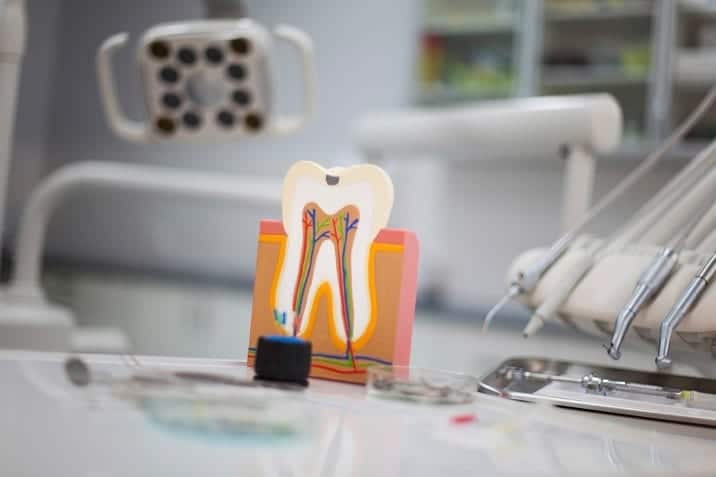Did you break your weakened teeth but not to the point that you’ll need a crown to protect it? Are there small holes all over your teeth due to dental caries? If any of those scenarios is the case, then you should look into getting tooth fillings on those cavities to save your tooth or teeth from further harm and degradation. The main things that make composite resin the default filling material for dentists is that it’s the inexpensive option to fix your teeth. It’s also both fast and minimally invasive. What’s not to love about it?
This article was made to promote knowledge about and understanding of various oral health topics, which includes the composite bonding procedure. It’s not intended to be a substitute for professional advice. Rather, it should spur you to seek advice in case you do feel like you’re in need of such a procedure so that the dentist can give you a specific diagnosis and treatment plan based on your dental or oral condition.
What Is Composite Resin Repair?
Even though your teeth is covered by an enamel shield—the most mineralized and hardest human tissue in the body—it does have a breaking point. Its strength has limits that can be tested by biting down something hard, suffering a punch to the face, falling, or going through a car accident.
- Decayed Teeth Are Susceptible to Breaking: Teeth that have decayed somewhat are particularly susceptible, like wood in the sea suffering from wood rot. Once your teeth have been chipped or broken, don’t fret. There are many things a dentist can do to fix it, particularly composite resin filling or repair.
- Weakened Teeth Require Dental Restoration: If your teeth are weak enough and lacks calcium, you might end up breaking your tooth enamel in the process, which necessitates either repair via composite resin filling all the way to putting a crown over it before the damage reaches your tooth root nerve and requires a root canal procedure.
- The First Line of Dental Restoration: Composite bonding or composite resin bonding is the cosmetic dental technique that makes use of composite resin in order to cover up holes and gaps on your teeth caused by dental caries and cavity formation. It can be in filling form or bonding form for veneers. This makes it your dentist’s first line of dental restoration.
- A Restorative Technique to Fill In Teeth Holes: Composite bonding is something you can depend on as a cosmetic technique in order to fill in the potholes in your teeth. The dental material known as composite resin is molded and shaped unto your teeth in a way that doesn’t make it conspicuous once it sets in. It can also be used to fit in new veneers like glue.
- Ways to Break Your Teeth and Amalgam Fillings: This bonding process usually involves fixing cavities on teeth due to the acids produced by the waste products of sugar-and-starch-feeding bacteria. It can also involve you simply crunching on a piece of hard candy, ice, or cracker nuts. However, an alternative filling known as amalgam is also available.
How to Care for a Chipped or Broken Tooth

If you’re broken, chipped, or fractured your decayed tooth, see your dentist ASAP. You should have it filled in then take care of the filled-in tooth so that it doesn’t break apart again. Ditto if your teeth are decayed or have cavities. Otherwise, your tooth can get further damage or become infected outright, possibly requiring the extraction of said tooth if it doesn’t fall off of your mouth by itself once it dies.
Meanwhile, let’s delve deeper into following these self-care measures that could prevent you from breaking your teeth or suffering from cavities in the first place.
- Check for AML: Get checked for acute myeloid leukemia right after diagnosis of teeth breakage. Learn all of the tests required to find if you have AML and what sub type it is so that the proper treatment options are presented to you.
- Painful Broken Tooth: If the broken tooth is painful, take over-the-counter or OTC pain relievers like acetaminophen. You can also relieve the pressure and throbbing ache by rinsing your mouth with salt water.
- Sharp or Jagged Edge: If your broken tooth has a jagged or sharp edge due to the damage it got, cover it with a sugarless chewing gum or a piece of wax paraffin to keep it from cutting the insides of your mouth, cheek, lips, and tongue.
- Eating with a Broken Tooth: If you must eat with a broken tooth, avoid biting down on the damaged tooth and mostly eat soft foods like oatmeal and gelatin. You can also drink liquid foodstuff like soups, broths, and the like.
- Severity of The Damage: Whether our chipped or broken tooth as well as dental cavity requires a composite resin filling, reshaping it into a veneer, or outright dental crown depends on the severity of the damage. One office visit is enough to fix an enable that broke off. An outright broken or badly damaged tooth might require a costlier procedure.
- Why Composite Resin? Composite resin bonding or filling repair is the first line of defense against any broken or fractured tooth as well as cavities induced by dental caries. They’re the most affordable option to save a tooth prior to decaying altogether. However, preventing decay is usually better than the cure or repair procedures.
What to Expect from Composite Resin

When a dentist bonds the composite resin unto your tooth cavity or teeth cavities, he’s essentially applying plastic material that’s colored in the same shade as your teeth to repair discolored, fractured, chipped, or decayed teeth. It can also be used to make short teeth appear longer or serve as a more cosmetic and safer type of filling when compared to the gray coloration of amalgam fillings.
- A Cosmetic Technique Ultimately: Although composite resin serves a function in keeping your cavity-ridden teeth whole until you’re in need of a dental crown, it’s ultimately a cosmetic technique that allows your teeth to get fixed without it being obvious to the naked eye that it needed fixing. It’s molded unto the teeth, usually the front ones, to give the appearance of a straighter and at times wider smile while sacrificing a little bit on toughness when compared to dental amalgam that combines mercury with other metals to form the filling. This is why amalgam is usually placed at the molars, where they’re more inconspicuous.
- The Price for Composite Resin Bonding: According to Everyday Health, bonding price can range from $300 to $600 per tooth for simple procedures such as filling in cavities and whatnot. Many dental insurance premiums don’t cover cosmetic bonding. Regardless, make sure to ask if it will cover a portion of the cost, particularly if it’s deemed a medical necessity. At Thantakit Dental Center, it costs ฿900 to ฿2,000 for kids and ฿1,000 per surface for adults. Checkup and consultation cost ฿300 to ฿1,000. Composite resin veneer bonding costs ฿5,000.
- Like Fixing Roadwork with Cement versus Asphalt: The difference between composite bonding and dental amalgam is the same as with cement versus asphalt when fixing the road. Composite resin is like filling a holey role with cement; it blends perfectly with the rest of the street as if it’s been remade from the ground up. However, even though dental amalgam, like asphalt, looks more obvious when used on a street with its darker complexion, both are tougher against the things that broke the street in the first place despite their failure to blend in.
- A Solution to Various Conditions: Composite resin dental repair can be used as a functional or aesthetic form-fitting solution to various dental maladies and conditions such as staining in both teeth and previous fillings, gapped teeth, and chipped teeth. As long as there’s still a lot of the enamel and dentin surface available, you can still drill then put in tooth-colored resin on your teeth with no problem. However, paradoxically, the more you work on the same tooth because the resin filling keeps falling off or the cavity keeps growing larger, the more ineffective the filling becomes, thus necessitating crowns and jackets.
- The Benefits of Composite Resin versus All Other Restorations: Unlike porcelain veneer placement that requires you to take more than two visits to fixed chipped, holey, or fractured front teeth, a composite resin bonding procedure can be completed in one visit. Sure, you can say the same with mercury-based amalgam fillings, but those fillings are falling way out of style due to its use of mercury that’s poisonous to the body, such that there are procedures available to remove such fillings from your teeth safely in order to give it composite resin restorations instead. These fillings are also too dark colored for use on any of your front teeth like your incisors or canines.
- To Whom Is Composite Bonding Right For? Not everyone is compatible with composite resin fillings or bonding. If you have a crooked smile due to an underbite or overbite, this isn’t the treatment for you. Instead, you need bite adjustment in the form of orthodontics or some other treatment that deals with any complex gaps or chips in your teeth. The same applies to teeth cavities that are so deep that they’ve started causing toothache. Bonding is for those who seek a cosmetic solution for holey teeth that are otherwise healthy. A high level of technique is needed to make a natural shape and mold for the filling, so hire an experienced dentist to do this procedure for you.
- How Dependable Is Composite Resin Technology? According to the American Dental Association or ADA, this safe and effective technique was invented more than half a century ago and has become widely available for about 40 years. It’s an efficient and dependable process due to the nature of the fillings, thus making it easier for you and your dentist to go about it. It’s straightforward and lasts about an hour or so with a typical dental walk-in visit or appointment. It can serve as effective filling material or a reliable bonding agent for veneers.
- What Happens During Your Visit? The treatment involves removing some of the surface enamel to make the composite resin bond better with your tooth or teeth. It’s also for this reason that it’s discouraged for you to put in fillings repeatedly on the same tooth because it gets drilled over and over until the cavity widens too big for the filling to stick. The drilling nevertheless allows the dentist to shape the composite resin on your tooth effectively. Afterwards, a bonding agent is applied then the resin filling itself. It’s cured with a special light then finished off with a teeth polishing.
- What Aftercare Is Needed? Today’s modern composite resin material is tough enough to last without regular aftercare. You won’t need to call your dentist or get follow-up visits for the sake of maintenance. However, make sure to attend your regular dental checkups every 6 months and observe daily oral care (brushing 2-3 times a day, flossing, and gargling with mouthwash) as a top priority. Certain brands can improve your gum strength by 45 percent for gumline maintenance. You should also not bite down on ice or hard foods to prevent teeth breakage.
Conclusion

For all those who wish for their smile to shine brighter and become more beautiful or handsomer, composite resin bonding is the treatment to get. Make sure to take care of your necessities when it comes to oral health maintenance first before getting treatment though. If preventive maintenance fails and you end up with cavities, you can use this service to make your holey teeth whole again, with the caveat that you should double your efforts in removing the root or source of your dental caries in the first place.
It does have its drawbacks though, such as it being unable to support a tooth with dental caries that are too big and whatnot. However, understanding what makes you a good candidate for this procedure can help you decide whether availing of this simple services is a good investment for you or not. At any rate, always ask for the advice of your dentist or similar qualified healthcare providers with any questions you may have regarding a dental condition or treatment for such.
Thantakit International Dental Center is Thailand’s longest established dental center. Situated in Bangkok, our clinic is renowned across the world as a destination for world-class dentistry, with most of our patients flying to us from Australia.
Please contact us today and get a FREE dental consultation.












